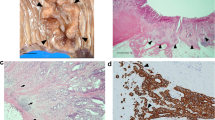Abstract
Hirschsprung's disease (HD) is characterised by the absence of ganglion cells and the presence of hypertrophic nerve trunks in the distal bowel. It has been suggested that aganglionosis may be caused by failure of differentiation as a result of microenvironmental change after neuronal migration has occurred. Recently, it was reported that cell-adhesion molecules (CAMs) and fibroblast growth factors (FGFs) stimulate neurite outgrowth through activation of FGF receptors (FGFRs) in neurons. The aim of this study was to investigate the expression of CAMs FGFs, and FGFRs in ganglionic (NG) and aganglionic (AG) segments of HD in order to understand the role of CAM-FGF signalling in the pathogenesis of HD. Specimens from NG and AG segments of bowel from 11 patients with HD were obtained at the time of definitive pull-through operation, snap-frozen in OCT compound, and stored at −70 °C. Aganglionosis was confirmed by Haematoxylin and eosin staining and acetylcholinesterase histochemistry; 8-μm cryosections were immunostained using the standard streptavidinbiotin-immunoperoxidase method. The following antibodies were used as the first antibody; FGF2 and FGF7 for FGFs, FGFR1 and FGFR2 for FGFRs, NCAM, L1CAM, and N-cadherin for CAMs. FGF2, FGF7, and FGFR2 were expressed in neuronal tissue of NG segments as well as in hypertrophic nerves of AG segments. There was a lack of FGFRI expression in neuronal tissue of both NG and AG bowel. Immunoreactivity with all three CAMs was detected in ganglion cells in NG bowel and in hypertrophic nerve trunks in AG bowel. In contrast the numbers of CAM-positive nerve fibres in muscle layers were markedly decreased in AG bowel compared to NG bowel. The markedly decreased expression of CAMs on nerve fibres within the muscle of AG bowel suggests that CAM-FGF signalling is altered in HD, resulting in failure of enteric neuroblast migration.
Similar content being viewed by others
Author information
Authors and Affiliations
Rights and permissions
About this article
Cite this article
Yoneda, A., Wang, Y., O'Briain, D. et al. Cell-adhesion molecules and fibroblast growth factor signalling in Hirschsprung's disease. Pediatr Surg Int 17, 299–303 (2001). https://doi.org/10.1007/s003830100598
Issue Date:
DOI: https://doi.org/10.1007/s003830100598




